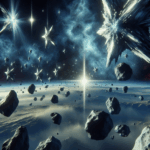The universe is bad at keeping secrets, but dark matter? It’s been playing the long con. Supposedly making up 85% of the cosmos’s mass, this shadowy substance refuses to interact with light, sound, or human curiosity. Scientists have been chasing it for decades, armed with billion-dollar detectors that mostly collect disappointment.
But something strange is happening at the heart of our galaxy. A team of researchers thinks they’ve found a fresh lead—one that suggests dark matter isn’t just lurking in the void but actively messing with the chemistry of space itself. And if they’re right, it could mean dark matter is… lighter than we ever imagined.
Dr. Shyam Balaji, a Postdoctoral Research Fellow at King’s College London, explains the central enigma: “At the centre of our galaxy sit huge clouds of positively charged hydrogen, a mystery to scientists for decades because normally the gas is neutral. So, what is supplying enough energy to knock the negatively charged electrons out of them?”
The usual suspects—cosmic rays—don’t seem to fit the bill. The energy readings from this volatile patch of space, known as the Central Molecular Zone (CMZ), don’t match what cosmic rays would produce. And the old favorite theory of dark matter—those elusive Weakly Interacting Massive Particles (WIMPs)—isn’t looking much better.
Enter a new possibility: a lighter, faster form of dark matter that might be annihilating itself in the CMZ, releasing charged particles in the process. These rogue particles could be ionizing the hydrogen gas, explaining why it’s shedding its electrons like a stressed-out stockbroker.
For years, dark matter research has been stuck in a loop—waiting for something big and WIMP-shaped to waltz into detection range. But this study flips the script. Instead of peering into underground labs, the researchers are treating the CMZ like a cosmic crime scene, looking for energetic fingerprints in the gas itself.
If their theory holds up, it could breathe new life into the idea that dark matter isn’t just some ghostly gravitational glue but a fundamental player in the chemistry of the universe. And that raises a much bigger question: if dark matter can shape the galactic landscape, what else has it been up to while we’ve been looking the other way?
Dr. Balaji sums it up with an understated kind of excitement: “The data is telling us that dark matter could potentially be a lot lighter than we thought.” Translation: everything we assumed might be wrong. Again.
If this discovery pans out, it won’t just tweak the textbooks—it could force a total rewrite. The hunt for dark matter has been a long, frustrating chase through shadows. But maybe, just maybe, we’ve been looking in the wrong places all along.
Five Fast Facts
- The Central Molecular Zone (CMZ), where this phenomenon is unfolding, is one of the most turbulent and extreme environments in the Milky Way.
- Dark matter was first hypothesized in 1933 by Swiss astronomer Fritz Zwicky, who noticed galaxies weren’t behaving the way they should gravitationally.
- WIMPs, the once-popular candidates for dark matter, have been the target of decades of high-budget detection experiments—all of which have come up empty.
- The Large Hadron Collider, the world’s most powerful particle accelerator, was partially built to search for signs of dark matter—but so far, no dice.
- Despite making up most of the universe’s mass, dark matter still hasn’t been directly observed, making it one of the biggest mysteries in modern physics.





